商学部(塾外用) - 慶應義塾大学-塾生HP
商学部(塾外用) - 慶應義塾大学-塾生HP
商学部(塾外用) - 慶應義塾大学-塾生HP
You also want an ePaper? Increase the reach of your titles
YUMPU automatically turns print PDFs into web optimized ePapers that Google loves.
INDIA TODAY 2credits (Fall)<br />
現代インド事情 2単位 (秋学期)<br />
Class, Caste, and Gender in India<br />
Lecturer NISHIMURA, YUKO<br />
講師 西村 祐子<br />
Course Description:<br />
This is a 'crash course to learn about India today.' Students who have<br />
not studied about Indian society are welcome.<br />
Class, caste, and gender are still key elements to understand globalizing<br />
Indian society. We will study how they are inter-related, and how the<br />
cultural difference between the North, the South, and the West and the<br />
East has created India’s cultural identities. We will also compare India<br />
with Japan and other Asian countries and discuss how they are similar.<br />
Key issues such as India's Dalits (the ex-Untouchables),women and<br />
religion, religion and politics etc., disparity between urban and rural areas<br />
will be discussed in relation to the emergence of Indian civic sector. The<br />
class will ultimately lead you to think about modernity in Asia.<br />
Textbooks:<br />
Reading materials will be given via online studies site.<br />
Reference Books:<br />
Das Guruchan 2004 India Unbound Penguin Books<br />
Harriso J. & Corbridge S. 2003 Reinventing India. Oxford Univ. Press.<br />
INDIAN MUSIC 2credits (Spring)<br />
体系学としてのインド音楽 2単位 (春学期)<br />
Systematics, Mathematics, Linguistics and Poetics in Indian Music:<br />
Practical and theoretical studies in creative expression<br />
数学・言語学・詩学・音楽学をむすぶ理論と実践<br />
Lecturer HOFFMAN, T.M.<br />
講師 ホッフマン, ティ エム<br />
Course Description:<br />
While Western music studies train individuals to follow a written script<br />
(notation) in a group situation featuring harmony, in Indian classical<br />
music the student is trained to improvise based on principles of melody<br />
and rhythm. This resembles the process of speech in language, where<br />
information and ideas are given form in verbal communication through<br />
spontaneous combination of phonetics and grammar. Proficiency in<br />
speech can also be nurtured through applying the time-tested theories and<br />
practices of Indian music. This is best achieved through the enjoyable<br />
study and practice of rhythm, melody and text in vocal music. This course<br />
will examine structural features of Indian music and apply them in<br />
experiencing the process of improvisation. Systematic exercises in rhythm<br />
and melody will introduce sophisticated concepts of time and space.<br />
Indian vocal music compositions will present language in relation to<br />
melody and emotion. Exercises for group, pair and individual will be<br />
introduced, and participants will be encouraged and assisted in composing<br />
and improvising upon their own creations. This course will promote<br />
understanding of the world of creative arts in general.<br />
No prior experience in music or performing arts is required.<br />
Textbooks:<br />
CD "Khyal and more: Vocal art of Hindustan" JVC VICG 60322 (w/<br />
notes in English & Japanese)<br />
Printed materials will be provided by the lecturer.<br />
Reference Books:<br />
(will be introduced in the course)<br />
LISTENING TO ASIA 2credits (Spring)<br />
アジアの音楽 2単位 (春学期)<br />
Sounds Divine and Mundane in Nature, Language and Music<br />
音楽・言葉・自然の音の構成・神性・魅力<br />
Lecturer HOFFMAN, T.M.<br />
講師 ホッフマン, ティ エム<br />
Course Description:<br />
We will become familiar with the sound culture of Asia, focusing on<br />
the various natural environments, languages and musics in the region with<br />
82<br />
a view to discovering both distinctions and universalities that may also aid<br />
us in understanding other disciplines and regions. From their origins in<br />
classical India, Greece and China and evolution in other places and times,<br />
we will trace influences of sound in health, religion, society, politics, and<br />
material worlds of traditional and contemporary culture. Examining<br />
principles and examples of instruments, rhythm, melody, improvisation<br />
and composition, we will approach music as both art and science, and<br />
discuss its interface with mathematics and linguistics. We will try to be<br />
aware of cultural and economic development, regional identity and<br />
globalization, and gender and other factors facing the makers and<br />
consumers of sound culture, and recognize East-West and North-South<br />
exchanges that have shaped our respective musical and linguistic<br />
identities.<br />
We will begin with a survey of the nature of sound and its use as a<br />
means of communication and expression, then travel through the sound<br />
cultures of Asia with the aid of audio-visual materials, live music<br />
demonstrations, and whatever other resources are available. Students will<br />
find opportunities for active participation, and to share their perceptions<br />
and experiences in class.<br />
Textbooks:<br />
Printed materials distributed in class.<br />
(CD) JVC World Sounds Best 100 地球のうた. Japan Victor Co., 2000.<br />
(optional: available in course directly from the lecturer)<br />
Reference Books:<br />
Audio-visual and other materials (in English and Japanese) to be<br />
introduced in class.<br />
INTRODUCTION TO CONTEMPORARY AUSTRALIAN<br />
SOCIETY 2credits (Spring)<br />
現代オーストラリア社会入門 2単位 (春学期)<br />
Introduction to Contemporary Australian Society:<br />
History, Culture and Environment<br />
Lecturer HAWKINS, GAY<br />
講師 ホーキンズ, ゲイ<br />
Course Description:<br />
This course examines key features of contemporary Australian society.<br />
It explores three main themes: histories and identities, culture and politics,<br />
and environments. Students will be introduced to the main forces that<br />
have shaped Australian society and national identity. They will also<br />
examine the ways in which these forces have changed understandings of<br />
what it means to be ‘Australian’ in a rapidly globalising world. How have<br />
colonisation, indigenous populations and mass immigration produced<br />
different meanings and experiences of ‘being Australian’? Other key<br />
questions to be examined will be: how is Australia positioned in relation<br />
to its region? What role have European, American and Asian influences<br />
played in its development and identity? And what are the unique issues<br />
and conflicts that shape Australia as a modern, developed nation in the<br />
21s t century?<br />
Textbooks:<br />
David, Carter. (2006). Dispossession, Dreams and Diversity: Issues in<br />
Australian Studies 1st ed.Pearson Longman. ISBN: 1-74091-096-6<br />
Reference Books:<br />
Catriona, Elder. (2007). Being Australian: Narratives of National<br />
Identity 1st ed. Allen & Unwin. ISBN: 978-1-74114-928-9<br />
AREA STUDIES (THE UNITED STATES) 2credits (Spring)<br />
地域文化論(アメリカ) 2単位 (春学期)<br />
Multicultural History of the United States<br />
Professor, Faculty of Law OKUDA, AKIYO<br />
法学部教授 奥田 暁代<br />
Course Description:<br />
One in three Americans is now a member of a minority group. The<br />
heated national debate on how government should respond to illegal<br />
immigration reveals the country’s anxiety about the changing face of<br />
America. Yet the United States has always been multiracial/multicultural<br />
and indeed shaped by the presence of diverse groups. The objective of this




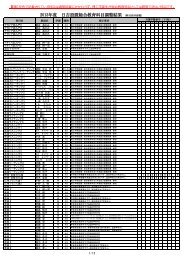
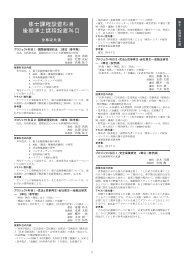
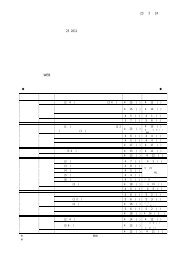
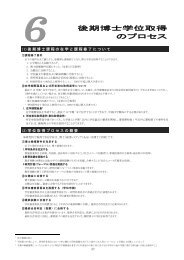
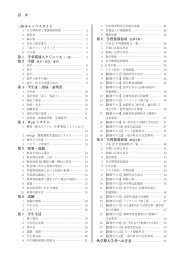



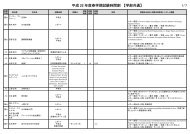

![文学部時間割表[2 ・3年生(07学則)]](https://img.yumpu.com/21046130/1/184x260/2-307.jpg?quality=85)

